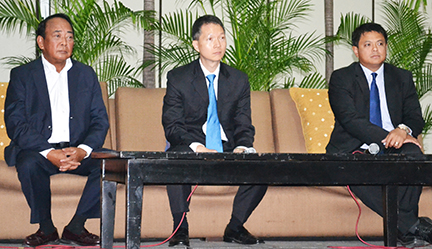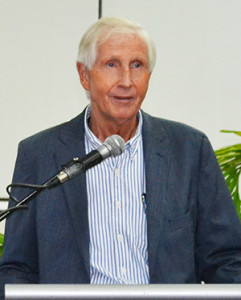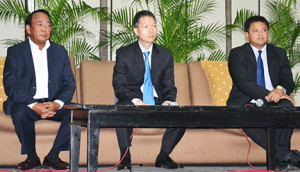

Businesses are urging the Philippine government to step in and end the economic hemorrhage and erosion of competitiveness caused by the city’s truck ban.
At the recent Transport Summit 2014 organized by the Philippine International Seafreight Forwarders Association and PortCalls, Henry Schumacher, vice-president for external affairs of the European Chamber of Commerce of the Philippines (ECCP), said the truck ban is a “blow to the economy”.
A sector directly hurt by the trucking prohibition was electronics, which accounts for about 40% of Philippine exports.
Interviewed on the sidelines of the Transport Summit, Semiconductor and Electronics Industries in the Philippines, Inc. president Dan Lachica said the industry expects 5% growth this year that may be downgraded if delays in shipments due to the truck ban continue.
Schumacher cited the recent Citigroup report on the truck ban costing the country from P61.2 billion to P320 billion in losses and hindering GDP growth by 1-5%.

The Office of the President should get involved now, as the situation is no longer just a local issue confined to Manila, but a matter of national interest “where the nation has to stand together” and find immediate solutions, Schumacher said.
For a mid-term solution, he suggested asking the contractor of the North Luzon Expressway-South Luzon Expressway connector road project to “build a connector (road) into the harbor.” If that happens, 70% of container traffic would be taken off Manila’s streets, he pointed out.
Something concrete is being done in that direction, according to Christian Gonzalez, general manager of Manila International Container Terminal (MICT).
In an email to PortCalls, Gonzalez said “a final feasibility study is already being undertaken by Metro Pacific Tollways and they are bullish on building this sector which will come down close to MICT and which will connect directly to the NLEX-SLEX connector.”
He added that MICT “(has) been involved with (Metro Pacific Tollways) in this and support their plans and ECCP’s recommendations 100%.”
Andrew Hoad, vice-president of Asian Terminals, Inc., which operates the Manila South Harbor, told PortCalls any infrastructure project is welcome, while Richard Barclay, chief executive officer of the Manila North Harbour Port, Inc., said the domestic port operator has been promoting the idea of connector roads to Manila’s ports.
Schumacher also suggested a truck appointment system whereby “trucks only come in by appointment, but that requires a steady flow.”
The Confederation of Truckers Association of the Philippines also earlier suggested an appointment scheme, but its members seem uninterested. Still the CTAP board is keeping that option open.
Schumacher listed other immediate concerns of the transport sector such as pileup in empty containers, informal settlers, truck traffic, and hurdles to supply chain efficiency related to customs, the container terminals, and shipping lines.
He said the ECCP recently sat down with the National Housing Authority and the “bad news” was that they don’t see the harbor as a “disaster area” and will not move the settlers immediately.
But the good news, he said, was that NHA identified a relocation site 200 meters away from the ports, and that the land that will be freed can be used for additional truck parking areas.
Still at the Transport Summit, National Economic and Development Association deputy-director general Dr Emmanuel Esguerra acknowledged lifting the truck ban “will probably require a decision at a much higher level” but that the national government cannot do much because of the autonomy of local government units.
He said local government autonomy is “something not confined to this (truck ban) issue. It is an issue that resonates on other policies as well,” citing right of way as an example. The subject of local government autonomy will require “legislative action for the long term” and “a middle ground” in the immediate term, he added.
Schumacher said closing Manila ports is not an option “if the well-being of the economy matters”. The ports should be made more effective by improving the infrastructure leading to them, which is “an urgent option”.
He concluded that moving traffic to the Batangas and Subic ports is a “necessity.”
Chicken and egg, Batangas and Subic
During the summit panel discussion, Asian Terminals Inc (ATI) vice president Sean Perez said ATI now provided the “nest” for the chicken-and-egg issue on Batangas.
The question, Perez said, is “who will take the active role now?”
“(Shippers) whenever they go to us they ask, ‘Where is the shipping line?” OK, we go to the shipping line, and they say, ‘Oh, the cargo has to be there.’ So, who’s now pushing?”
He added, “The chicken and the egg will now have to come together and hatch,” noting that as a port operator, ATI cannot dictate on the shipping line which port to call.
“I have to throw back the question, and request, wherever we are, please help us out, we cannot be alone. The triangle must be met,” Perez said.
At a separate presentation during the summit, Subic Bay Metropolitan Authority (SBMA) and ATI said the ports of Subic and Batangas are “ready, willing, and able” to handle cargoes.
SBMA chairman Roberto Garcia said shippers can save as much as 12.3% or US$140.47 when they import through Subic rather than Manila, and as much as 14% or $143.48 for exports.
Garcia announced SBMA accreditation by port users have also been made simpler. He said cargo truck accreditation is now done in just a day, with a green lane provided for trucks at the Tipo Sentry Gate.
In addition, Garcia said the Bureau of Customs in Subic committed to an 8-hour processing time while the SBMA Seaport Department will shorten the processing of gate pass application to six hours.
As for Batangas port, Perez said “it is the natural gateway for the Calabarzon hinterland due to its modernity, proximity and cost-efficiency.”
He added more port users and truckers, including members of CTAP and the Portusers Confederation, have expressed interest in Batangas. The Philippine Liner Shipping Association also went on a port tour recently to assess its potential.
On another note, ATI vice president Andrew Hoad said MCC, the intra-Asian arm of Maersk Line, is adding a new service in Batangas in the next weeks. –– Text and photos by Roumina M. Pablo




